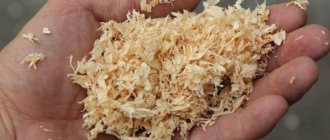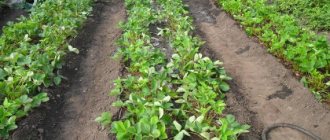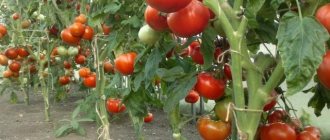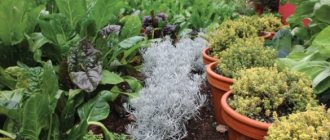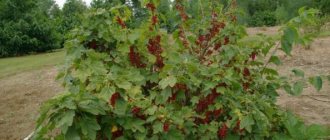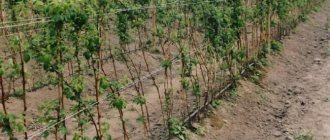Category: Growing and care Reading time: 8 min · Views: 7,144
How to harvest a rich harvest of garlic from your plot? To do this, it is necessary to regularly feed the soil with fertilizers, since over time, nutrient reserves become depleted. Fertilizing garlic involves the use of organic substrates and agrochemical fertilizers. It is important to feed the beds with useful substances in a timely manner so that the garlic grows large and tasty. Let's consider all types of fertilizers used in spring and autumn.
Mineral fertilizers
Industrial agrochemicals contain a balanced complex of microelements important for crops: nitrogen, potassium and phosphorus. Widely used in gardening:
- urea (urea);
- ammonium nitrate;
- superphosphate;
- nitroammophoska.
Urea
Urea is rich in nitrogen compounds necessary for the development of green mass. Urea is used for spring feeding of plantings so that the leaves begin to actively grow. To prepare the working solution, dissolve a tablespoon of dry substrate in a bucket of settled water. One bucket is enough to irrigate 3-3.5 m2 of planting area.
Ammonium nitrate
Ammonium nitrate is also used in early spring due to its high percentage of nitrogen compounds. To prepare the substrate, 15 grams of dry matter are dissolved in a bucket of water. Three liters are enough to feed 1 m2 of planting area. Garlic is fed with saltpeter twice, the interval between feedings is 25-30 days.
Superphosphate
Superphosphate is necessary for garlic to form the root system and head. With phosphorus deficiency, garlic grows small and tasteless, is poorly preserved in winter and gets sick. To prepare the solution, you need to dilute a couple of tablespoons of dry substrate in a bucket of settled water. A bucket is enough to replenish a planting area of 2 m2.
Nitroammofoska
Nitroammofoska is a universal fertilizer that replaces the use of superphosphate and ammonium nitrate. The composition of nitroammophoska contains all the microelements necessary for the nutrition of garlic. In addition to nitrogen and phosphorus compounds, the agricultural product contains sulfur. For irrigation, use a saturated solution (2 tablespoons per bucket of water); for irrigation, the concentration is halved.
Soil preparation
Garlic is picky about soil acidity; it grows poorly in acidic soils, preferring neutral ones. You can determine acidity by looking at the weeds growing in your garden. The growth of plantain, horsetail, and buttercup in the area indicates high acidity. Clover and nettle grow in neutral soils. To get a good harvest, if necessary, add substances that neutralize the high acidity of the soil. This can be any substance containing calcium - old slaked lime, dolomite flour, limestone, saltpeter.
You can determine the acidity of the soil using a water infusion of black currant leaves. If, when adding soil, the infusion turns pink, then the soil is of medium acidity. Red color indicates strong acidity, green indicates neutral soil composition. The blue color is given to the infusion by alkaline earth.
Soil structure is no less important. Heavy clay soils retain moisture and are poorly permeable to air. To improve the structure, perform the following actions (norms are shown per 1 square meter):
- In clay soils you need to add 1 bucket of peat.
- Add 3 kg of humus and compost, 1 tablespoon of superphosphate and the same amount of potassium sulfate, 200 g of lime to the loamy soil.
- Add 1 bucket of loam to peat soils.
- 2 buckets of clay and 1 bucket of peat are added to sandy soils.
Such additives will improve the soil structure and increase the yield of vegetable crops.
Organic complexes
Agrochemicals can be replaced with natural fertilizers. Many gardeners do this, taking into account the centuries-old experience of fertilizing the fertile soil layer with composts and other compositions of organic fertilizers, which our ancestors successfully used.
Organic fertilizers:
- manure;
- compost;
- ash;
- yeast;
- ammonia.
Manure
Applying manure to the garden is a proven and effective method of fertilizing. Experienced gardeners use rotted mullein instead of fresh cakes, since fresh substrate can burn out the delicate horse system of seedlings. Typically, manure is used before winter, so that during the cold season it has time to decompose in the ground and enrich it with useful substances. When watering with diluted mullein, be careful not to get on the green shoots. For irrigation, make a solution of part manure and seven parts water.
Compost
Compost can be made from a variety of ingredients. Garlic is especially responsive to compost with the addition of kitchen waste (potato peels, carrots, apples, etc.). Compost is added when digging the beds for planting.
Ash
Ash is used as a source of potassium and phosphorus. In early spring, there is no need to add ash fertilizers, since they do not contain nitrogen compounds. Ash is used in different ways:
- scattered over the beds;
- make a solution (half a liter per bucket of water);
- treat the leaves of seedlings to protect them from pests.
If you scatter dry ash on the leaves of seedlings in dry weather, this will protect them from garden pests and mold.
Yeast feeding of garlic
Yeast fertilizers are very popular among gardeners. The crops grow by leaps and bounds, becoming strong and hardy. To prepare the yeast solution, use both fresh and dry ingredients. Take 200 grams of fresh yeast per liter of water, stir well and leave to sit for a day. Then the finished concentrate is diluted in a bucket of water and used to feed the garlic. Yeast fertilizing is used in spring and summer.
Ammonia
Modern gardeners recommend using pharmaceutical ammonia to feed plants with nitrogen compounds. To prepare a working solution for watering, one bottle of ammonia (50 ml) per bucket of water is enough. To irrigate the green mass, make a less concentrated solution using 25 ml of ammonia per bucket. This solution feeds the garlic with nitrogen and protects it from pest aggression.
What are the benefits of such an unusual fertilizer, its types
Why is fertilizer so valuable? For the high content of various substances, for the rapid growth and development of plants, for the ability to improve the physical (structure, water permeability, air permeability) properties of the soil, for the fact that it introduces a huge amount of useful elements, serves as a source of energy and nutrition, increases fertility, and retains moisture well.
Potassium, calcium, magnesium, phosphorus, nitrogen, sulfur, and many different microelements are the most valuable elements contained in the fertilizer.
There are three types of manure:
- Slurry - animal urine that has fermented - is an excellent nitrogen-potassium fertilizer. It is collected in slurry containers in special livestock buildings.
- Litter - consists of material used for bedding (peat, straw, sawdust), solid and liquid excrement of domestic animals.
- Litterless - contains various animal excrements (liquid and solid), mainly with water. The mass is very fluid, so it is often used as slurry. It also comes in liquid and semi-liquid.
Winter garlic
This method of growing garlic is the most common. The cloves are placed in the garden bed before frost. Over the winter, garlic has time to take root well without developing green mass. Immediately after the snow melts, green arrows appear in the beds, and it will be possible to harvest an early harvest of young garlic.
Before planting winter garlic, it is necessary to fertilize the beds with nutrient substrates in advance. Humus is usually used. In early spring, it is necessary to immediately feed the beds with nitrogenous substances so that the greenery begins to grow. Feeding garlic after winter is important to activate the growth of green mass.
During the season, garlic is fertilized three times:
- After the snow melts, when the air temperature becomes above zero. Agrochemicals or manure solution are used.
- 3-4 weeks after the first feeding. This is due to the high humidity of the spring period, when meltwater and rain wash away nutrients from the fertile layer. Top dressing will provide the garlic with everything it needs for development. Use nitroammophoska or infusion of manure for irrigation.
- At the end of June, fertilizing is applied to form a strong bulb. During this period, garlic needs phosphorus compounds, so superphosphates and ash are used.
If the garlic leaves begin to turn yellow, you should check the soil for acidity. To reduce acidity, use dolomite flour or slaked lime. The substrate is scattered over the beds in accordance with the instructions.
Note! The shoots must be removed when they appear, as they take away nutrients from the crop. They are cut with a knife or scissors.
Drying of the tips of the leaves indicates a lack of nitrogen, so it is recommended to feed the plants with a solution of ammonia or ammonium nitrate.
If the leaves have lost their bright color, but have not turned yellow, it is recommended to apply potash fertilizers. You can use an ash solution for spraying or dig up ash between the rows.
If garlic grows slowly and does not develop green mass well, it is necessary to nourish the soil with complex fertilizers. Developmental delay indicates nutritional deficiency.
Fertilizing strengthens the immunity of seedlings to resist pests and diseases. Gardeners claim that weak seedlings are most susceptible to attack by phytofungi, insect pests and various diseases.
How to properly apply manure when planting garlic in the fall
Manure can be applied with caution in the fall. But there are two important nuances.
- The manure must be rotted.
- It is necessary to apply manure when preparing the soil a month before planting.
The consumption rate is approximately 5-6 kg per square meter of area.
It is impossible to apply manure in the fall directly during planting, since it will cause the plant to “fatten”, that is, to increase green mass.
But in general it is better to feed manure in the spring than in the fall.
Spring garlic
Immediately after the snow melts, spring crops are planted in the beds. Spring garlic has the same beneficial properties as winter garlic. The difference between them lies in the timing of germination and harvesting: spring crops ripen a month later. Spring garlic is also fertilized three times per season. The first fertilizing is carried out as soon as the first arrows of greenery appear. Feeding spring garlic in early spring does not make sense: only after emergence. The amount of nutrients introduced is the same as when feeding winter seedlings.
Then the beds are fertilized 2-3 weeks after the first feeding. The last feeding is carried out when the head of garlic has enlarged to the size of a nut. During this period, the crop needs phosphorus and potassium.
Autumn planting dates
Determining exactly when to plant this crop should depend on the climate of the region. But in any case, you need to guess the time a month to a month and a half before the onset of frost. If you hurry, the first frost will kill the crops, but if you are late, the bulbs will not have time to take root and will develop sluggishly in the spring.
Practice has shown that in central Russia, “winter” garlic, like winter onions, is best planted from September 20 to October 15, in Siberia - from September 15 to October 5, in the southern regions - at the end of October - beginning of November.
Rules for applying fertilizing
Experienced gardeners know how to properly fertilize crops with various substrates. Beginners in gardening make many mistakes when growing garlic and other plants.
Note:
- Watering of seedlings is carried out strictly at the root, without getting on the green mass. For convenience, it is best to use a watering can.
- Dry substrates are laid out on the surface of the ground so that they do not come into contact with the aboveground part of the seedlings. Then the beds are watered abundantly so that the water dissolves the nutrients.
- Before applying liquid root fertilizer, you should not pre-water the beds with clean water: garlic does not like excessive moisture.
- Do not water seedlings with too cold/hot water. The temperature of the solution must correspond to the ambient temperature.
- The working solution should be used immediately after preparation to prevent unwanted chemical reactions from occurring. If the solution sits for more than a day, it will lose its beneficial properties.
- Fertilizing garlic involves alternating organic substrates and agrochemicals. It is not recommended to give preference to any of them.
If the spring turns out to be rainy, it is better to replace root feeding with spraying. As a result of spraying, garlic receives all the necessary substances, but does not suffer from excess moisture.
Foliar feeding is used as additional nutrition for seedlings when there is a deficiency of microelements in the soil.
To prevent the solution from drying out in the sun after spraying, seedlings are treated in the evening or at dawn. This is the most optimal time to care for seedlings. The weather should be dry and calm: a strong wind will carry drops of the solution in a different direction, and rain will wash the nutrient solution from the leaves.
By following these tips, you can effectively care for your crops and reap a rich harvest from your garden beds.
Basic rules for feeding garlic in spring
Fertilizing with organic matter and minerals is carried out taking into account the stage of vegetation, soil conditions and ambient temperature. From the beginning of spring, garlic plantings are freed from shelter, and the soil is carefully loosened. Next, organize watering by dissolving 20 drops of iodine in 5 liters of water. Moisturizing with an iodine solution will enrich the soil and reduce the risk of plant damage by fungal diseases.
The beginning of the growing season is accompanied by vigorous growth of stems and leaves. The formation of the bulb occurs later, approximately when 8–10 leaves appear. To prevent yellowing of the stems and stimulate the growth of greenery, you will need nitrogen fertilizer for garlic. The treatment is carried out 2 times when:
- sprouts will hatch;
- It will grow about 6 leaves.
Preparing a bed for garlic
Experienced gardeners advise pre-growing green manure in the beds. These are plants that fertilize the fertile layer with the nutrition necessary for a particular crop. Garlic is often infested by helminths - nematodes. They settle in stems and destroy seedlings. After growing phacelia and white mustard in beds, nematodes do not attack garlic.
When is the best time to plant green manure? This is done when preparing the land for winter: after harvesting and digging. The plot is sown with green manure, and then it is plowed into the ground. Over the winter, the stems will rot and enrich the soil with nutrition.
Is it necessary to fertilize the beds before planting? Experienced gardeners advise applying compost fertilizers and then digging the beds using a full spade. For 1 m2 of planting area, use a full bucket of compost. After this, after a couple of days you can plant the cloves.
After which green manures can garlic be planted?
The most advanced summer residents grow green manure on their plot before planting vegetables. This is a very effective solution for saturating the soil with nutrients, increasing soil fertility and even disinfecting it.
There are many green manures. Garlic is “friends” with almost all of them.
Most of all, the culture “loves” mustard. This green manure repels pests.
The plant can also be planted after phacelia and barley. The first green manure significantly improves the quality of the soil. Barley is not so useful, but the soil underneath it “rests.”
IMPORTANT! Green manure must be removed at least 2 weeks before planting garlic so that it has time to decompose in the soil.
Bottom line
Growing garlic is not difficult if you strictly follow the recommendations in the article. It should be remembered that before planting seed, the land must be carefully prepared and fertilized. Winter and spring garlic require the same composition of fertilizers, but the timing of application differs. Both types of crops are fed immediately after the first leaves emerge, and then fertilized two more times at intervals of a month.
The first two feedings of garlic are aimed at activating the growth of green mass, the third feeding is aimed at the formation of a large head. As soon as the size of the head becomes the size of a walnut, potassium and phosphorus compositions are added. Nitrogenous substances are not added during the formation of the head, as they activate leaf growth. Remember that plants constantly draw all nutrients from the fertile soil layer. If the deficiency of nutrients in the soil is not replenished, the seedlings grow weak. Timely fertilizing of crops will provide you with a rich harvest of fruits.
Step-by-step instructions on how to feed a plant after winter
If you want the harvest to be rich and the resulting garlic to be healthy and fully formed, it is important to follow a special fertilizing technology. It is suitable for feeding both winter and spring garlic. The latter is planted in the spring, so it does not need autumn fertilizer.
The amount of fertilizing and its type is calculated individually. It is important to take into account the composition of the mail, the climate and the general condition of the plant. The main thing is to take into account the basic principles: the plant needs nitrogen fertilizers in the spring, when it is growing, and there is a need for phosphorus and potassium fertilizers during the formation of the head.
Autumn feeding
Helps to survive the winter and sprout in the spring. Before applying fertilizers, it is necessary to remove plant debris from the beds and dig up the soil . The following composition (per 1 sq.m.) is well suited for feeding:
- 5 kg of compost or humus;
- 15-20 gr. superphosphate;
- 15 gr. potassium chloride or potassium sulfite;
- You can also add 2 more cups of wood ash.
After applying the fertilizer, the soil must be dug up, leveled with a rake and watered with water with the addition of 1 tbsp. spoons of copper sulfate.
Important : Do not feed garlic with nitrogen compounds in the fall. They can lead to untimely growth of green mass.
Spring feeding
Acts as additional nutrition for the plant. Without it, garlic will have a hard time growing, especially if the soil is poor in the necessary chemical elements. In total, 2 feedings are performed in the spring :
- Fertilizer is applied 1-2 weeks after the snow has melted (for winter garlic). To do this, you need to dissolve 1 teaspoon of urea and the same amount of potassium chloride in 10 liters of warm water. Fertilize in the evening, before the main watering.
- Fertilizer is applied 2 weeks after the first spring feeding. To do this, you can add nitroammophoska (1 tablespoon) and 0.5 liters of cow grass to 10 liters of warm water. This feeding will promote the active growth of the plant’s green mass.
We recommend watching a video about spring feeding of garlic:
Summer feeding
It is carried out at the beginning of the formation of heads, that is, approximately during June.
To do this, dissolve superphosphate (2 tablespoons) in 10 liters of water. After applying the fertilizer, you need to water the garlic with plain water .
Summer feeding is carried out only after trimming the garlic shoots and loosening the bed.
When growing any varieties of garlic, it is important to know other nuances, namely, what diseases there are, how to treat before and after germination, propagation by seeds, and also growing garlic as a business.

